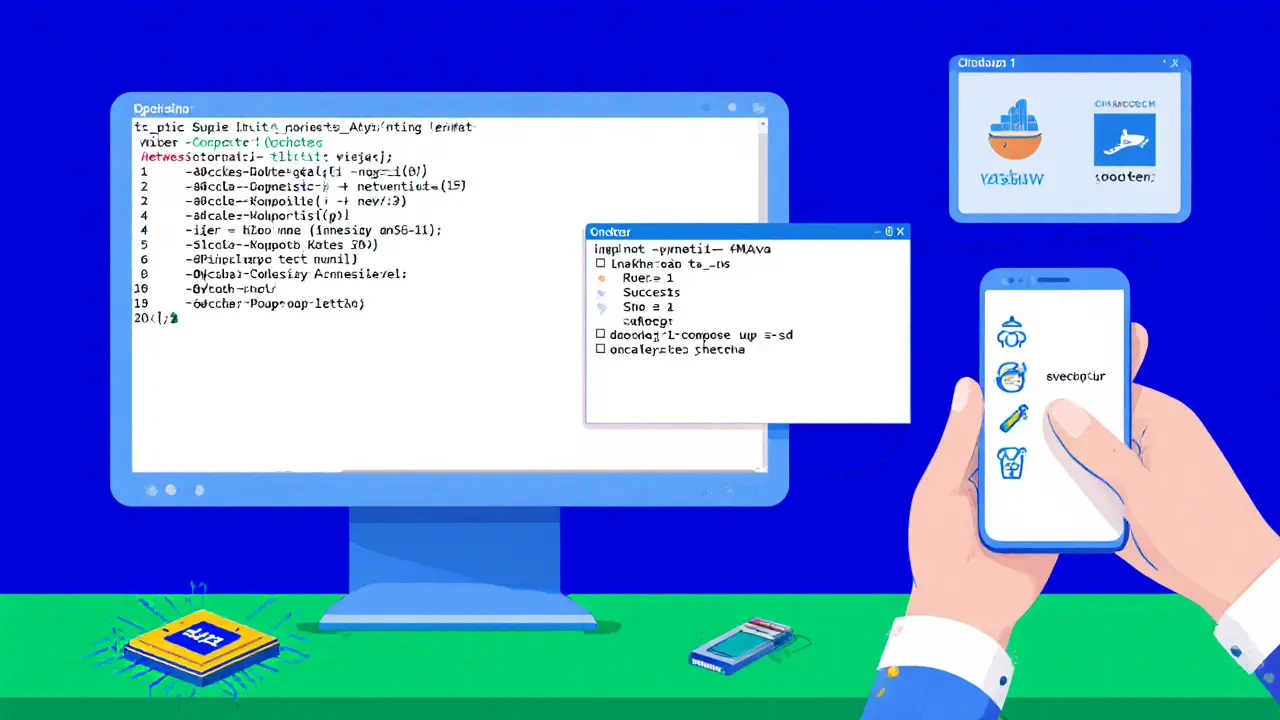Phala Network (PHA) Airdrop Eligibility Checker
Check Your Eligibility
Answer the following questions to see if you qualify for the Phala Network airdrop.
Your Eligibility Status
Ever wondered why a crypto airdrop sometimes feels more like setting up a mini data center than a simple tweet? The Phala airdrop breaks the usual mold - it rewards participants who actually run a privacy‑preserving miner node, not just those who like a meme. If you’re curious about how to claim those 30 PHA tokens, what technical steps are needed, and why the network’s move to Ethereum matters, keep reading. By the end you’ll know exactly what you need, where the rewards come from, and the risks you should weigh before diving in.
Key Takeaways
- Phala’s airdrop gives a fixed 30PHA (≈$3) to anyone who successfully runs a Phala miner node.
- The reward is tied to the launch of the pre‑mainnet version called “Darth Vader” and will be paid out after that milestone.
- Running a node requires Trusted Execution Environment (TEE) hardware, a few command‑line steps, and screenshot verification.
- Phala’s parachain slot expires on 20Nov2025, prompting a migration to an Ethereum Layer2 rollup.
- Potential participants should weigh hardware costs, timeline uncertainty, and the broader privacy‑blockchain market before committing.
What Is Phala Network?
Phala Network is a privacy‑preserving blockchain protocol that runs confidential smart contracts inside Trusted Execution Environment (TEE) hardware. Launched with a Token Generation Event on 12Sep2020, the network focuses on keeping data secret while still allowing reliable contract execution. By isolating contract code in TEE‑enabled miner nodes, Phala offers a native privacy layer that many other blockchains lack.
The project raised $1.43million across four private rounds and sits at a market cap of roughly $77million as of Oct2025. Its main differentiator is the combination of privacy and smart‑contract functionality, positioning it alongside other privacy‑focused projects like Oasis and Akash.
Understanding the PHA Token and Its Value
PHA token is the native utility token of Phala Network. Each token powers fee payments, staking, and participation in governance votes. At the time of writing, PHA trades around $0.1029, giving the airdrop’s 30PHA a market value of about $3.09. Daily trading volume sits above $16million, indicating solid liquidity despite a modest market cap.
Beyond price, PHA’s real utility comes from its role in securing the network’s TEE‑based contracts. Holding PHA allows users to stake on miners, earn a share of transaction fees, and vote on proposals such as the upcoming Ethereum migration.

How the Phala Airdrop Works
The airdrop isn’t a simple social‑media giveaway. Participants must download Phala’s mining software, configure a miner node that supports TEE hardware, and run a set of commands that prove the node is alive. Once the node is verified, the participant submits a screenshot via the official airdrop portal. After verification, the network earmarks 30PHA for that address, but the actual distribution will only happen when the pre‑mainnet "Darth Vader" version goes live.
Referral bonuses are also available - each successful referral can add a small extra amount, though the base 30PHA remains the core reward.
Technical Setup: Running a Phala Miner Node
Setting up a miner node takes about 2‑4hours for most users with basic Linux knowledge. Follow these steps:
- Verify hardware compatibility - you need a CPU that supports Intel SGX or AMD SEV, the two main TEE technologies.
- Download the latest miner package from the official Phala GitHub repository.
- Install required dependencies (Docker, Rust toolchain, and the SGX driver).
- Extract the package and run the initialization script:
./phala-node init --network testnet
- Start the miner:
docker-compose up -d
- After the node syncs (usually 30‑60minutes), execute the verification command provided on the airdrop page and take a screenshot of the successful output.
- Submit the screenshot along with your wallet address on the airdrop portal.
Once submitted, the Phala team cross‑checks the screenshot against their logs. If everything matches, your address is added to the pending reward list.
Timeline & Reward Distribution
The airdrop’s payout is explicitly linked to the launch of the "Darth Vader" pre‑mainnet. No firm date has been announced, but the network has indicated it will occur before the parachain slot expires on 20Nov2025. If the slot is lost, Phala plans to fully migrate to an Ethereum Layer2 rollup that went live in Jan2025. Participants should therefore expect reward distribution sometime in Q42025, with the exact window dependent on successful code audits and community approvals.
During the interim, the 30PHA sits in a “locked” smart contract, visible on-chain but inaccessible until the launch triggers a release function.

Comparison: Phala Airdrop vs. Typical Crypto Airdrops
| Aspect | Phala Airdrop | Typical Airdrop |
|---|---|---|
| Reward Size | 30PHA (~$3) | $5‑$50 worth of tokens |
| Eligibility | Run a TEE‑enabled miner node + screenshot verification | Wallet address + social media actions |
| Technical Barrier | High - requires specific hardware and CLI knowledge | Low - mostly copy‑paste tasks |
| Distribution Timing | Linked to pre‑mainnet launch (Q42025) | Usually within days of announcement |
| Utility of Token | Staking, fee payment, governance, privacy contracts | Often limited to governance or speculation |
The table shows why Phala’s airdrop attracts a more technically savvy crowd. The higher barrier filters out casual participants, potentially leading to a more engaged community of miners and developers.
Risks & Considerations
Before you invest time and hardware, weigh these factors:
- Hardware cost - TEE‑compatible CPUs are pricier than standard processors.
- Timeline uncertainty - Rewards won’t arrive until the Darth Vader version launches, and no firm date exists yet.
- Network shift - The upcoming move from a Polkadot parachain to an Ethereum Layer2 could affect token utility and miner demand.
- Competition - Other privacy projects (Oasis, Moonbeam) are also courting developers, which could dilute Phala’s market share.
- Regulatory environment - Privacy‑focused blockchains sometimes face stricter scrutiny, potentially impacting long‑term adoption.
All said, the airdrop offers a genuine stake in a network that’s actively building privacy‑preserving smart contracts. If you’re comfortable with the setup, it can be a low‑cost entry point to that ecosystem.
Next Steps for Interested Participants
- Check your CPU for SGX (Intel) or SEV (AMD) support. Use the manufacturer’s spec sheet or run
sgx-detect/sevctltools. - Create a dedicated wallet address that you control (e.g., MetaMask, Polkadot.js) - you’ll need it for reward receipt.
- Download the miner package from Phala’s official GitHub page. Verify the PGP signature to avoid tampered binaries.
- Follow the step‑by‑step setup guide in the Phala documentation. Allocate at least 8GB RAM and 100GB SSD for smooth syncing.
- Run the node, capture the verification screenshot, and submit it on the airdrop portal before the deadline (usually end of Oct2025).
- Monitor community channels (Telegram, Discord) for announcements about the Darth Vader launch date.
- After the reward is released, consider staking your PHA to earn fees while the network transitions to Ethereum Layer2.
Following this checklist will keep you on track and reduce the chance of hitting a hardware‑compatibility snag.
Frequently Asked Questions
What hardware is required to run a Phala miner node?
You need a CPU that supports Intel SGX or AMD SEV, at least 8GB RAM, and a solid‑state drive of 100GB or more. These features enable the Trusted Execution Environment needed for confidential contract execution.
When will the 30PHA airdrop reward be paid out?
The payout is locked to the launch of Phala’s pre‑mainnet version called "Darth Vader". While the exact date isn’t public yet, the network aims to release it before the parachain slot expires on 20Nov2025, so expect distribution in Q42025.
Can I claim the airdrop without running a node?
No. Phala’s airdrop is specifically designed to reward participants who run a TEE‑enabled miner node and submit verification proof. Simple wallet address submission won’t qualify.
What happens to the airdrop if Phala migrates fully to Ethereum Layer2?
The reward contracts are written to be upgradeable. Once the Ethereum Layer2 rollup is live, the pending 30PHA will be transferred to the same address on the new network, preserving the payout.
Is there a referral bonus for the Phala airdrop?
Yes. Each verified referral can add a small extra amount of PHA on top of the base 30PHA, though the exact bonus amount varies and is announced on Phala’s official channels.


Mark Bosky
Thank you for sharing this comprehensive guide on the Phala airdrop; it clarifies the eligibility criteria and the necessary technical steps for interested participants.